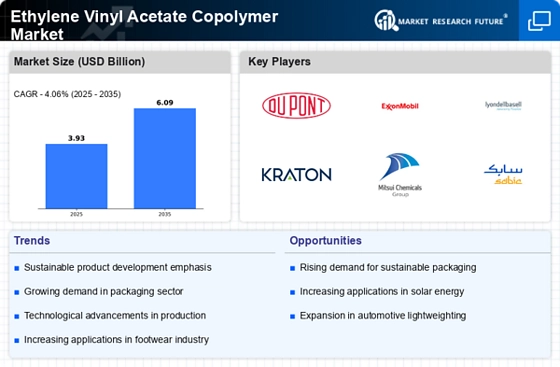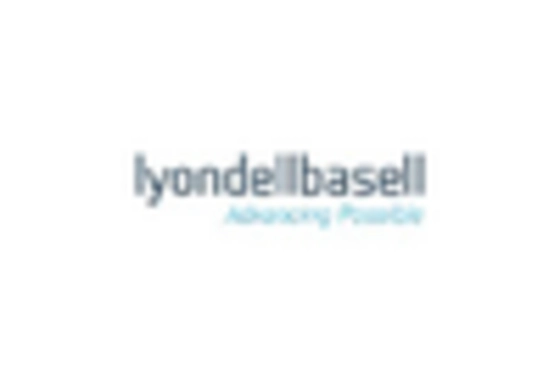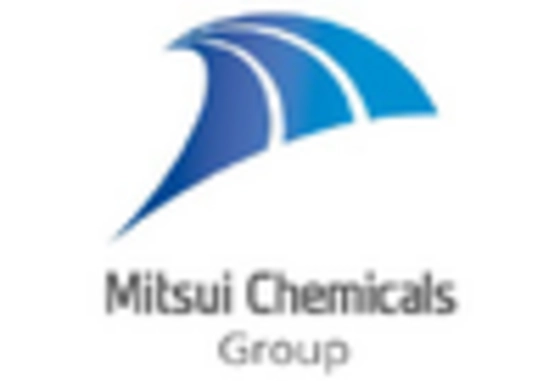Growth in Automotive Applications
The Ethylene Vinyl Acetate Copolymer Market is benefiting from the rising adoption of ethylene vinyl acetate copolymer in automotive applications. The material's properties, such as impact resistance and flexibility, make it suitable for various automotive components, including interior trims and seals. As the automotive industry increasingly focuses on lightweight materials to enhance fuel efficiency, the demand for ethylene vinyl acetate copolymer is expected to rise. In 2025, the automotive segment is anticipated to contribute significantly to the overall market growth, driven by innovations in vehicle design and manufacturing processes. Furthermore, the ongoing transition towards electric vehicles may also create new opportunities for the Ethylene Vinyl Acetate Copolymer Market, as manufacturers seek advanced materials to meet evolving performance standards.
Expansion in Footwear Manufacturing
The Ethylene Vinyl Acetate Copolymer Market is witnessing considerable growth due to its extensive use in the footwear manufacturing sector. The material's lightweight nature and cushioning properties make it a preferred choice for various types of footwear, including athletic and casual shoes. In recent years, the footwear segment has shown a robust growth rate, with projections indicating that it will continue to expand as consumer preferences shift towards comfort and performance. Additionally, the increasing trend of customization in footwear design is likely to further drive the demand for ethylene vinyl acetate copolymer, as manufacturers seek materials that can be easily molded and adapted to specific designs. This trend suggests a promising future for the Ethylene Vinyl Acetate Copolymer Market within the footwear sector.
Increasing Use in Medical Applications
The Ethylene Vinyl Acetate Copolymer Market is experiencing growth due to its increasing utilization in medical applications. The material's biocompatibility and flexibility make it suitable for various medical devices and packaging solutions. As the healthcare sector continues to evolve, there is a growing demand for materials that can ensure the safety and efficacy of medical products. In 2025, the medical segment is expected to represent a notable share of the Ethylene Vinyl Acetate Copolymer Market, driven by advancements in medical technology and the need for high-performance materials. Furthermore, the ongoing emphasis on patient safety and product reliability is likely to propel the demand for ethylene vinyl acetate copolymer in this sector, suggesting a promising outlook for the industry.
Rising Demand in Packaging Applications
The Ethylene Vinyl Acetate Copolymer Market is experiencing a notable surge in demand, particularly within the packaging sector. This increase is largely attributed to the material's excellent flexibility, transparency, and resistance to UV radiation, making it an ideal choice for various packaging solutions. In 2025, the packaging segment is projected to account for a substantial share of the market, driven by the growing need for lightweight and durable materials. Furthermore, the shift towards sustainable packaging solutions is likely to enhance the appeal of ethylene vinyl acetate copolymer, as it can be produced with a lower environmental impact compared to traditional plastics. As companies increasingly prioritize eco-friendly materials, the Ethylene Vinyl Acetate Copolymer Market is poised for significant growth in this application area.
Technological Innovations in Production
The Ethylene Vinyl Acetate Copolymer Market is poised for growth due to ongoing technological innovations in production processes. Advances in polymerization techniques and processing technologies are enhancing the efficiency and quality of ethylene vinyl acetate copolymer production. These innovations not only reduce production costs but also enable manufacturers to create specialized grades of ethylene vinyl acetate copolymer tailored for specific applications. As a result, the market is likely to see an influx of new products that meet diverse consumer needs. Additionally, the integration of automation and smart manufacturing practices is expected to streamline operations, further boosting the competitiveness of the Ethylene Vinyl Acetate Copolymer Market. This trend indicates a dynamic future for the industry as it adapts to changing market demands.


















Leave a Comment